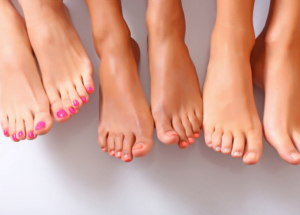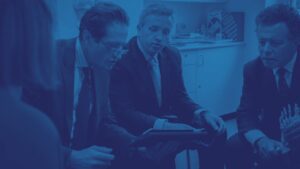


by Martin Klinke
LFAC Consultant
In July 2002 Ms. B. was referred for persistent pain in both feet, the right one worse than the left one. She was diagnosed suffering from plantar fasciitis and she described pain in both heels.


In her referral letter
It was mentioned that she had had the whole gamut of conservative treatment including physiotherapy and injections.
The cortisone injections did give her good pain relief each time for about six months and physiotherapy helped but symptoms recurred regularly. Ms. B. had recently moved to London and started to walk a lot more which caused her increasing pain not only under her heels but more so at the back of her heels.
The pain was quite pronounced in the morning when starting to walk and she experienced recurrent cramps in both calf muscles.
When I saw Ms. B. for the first time in clinics,
She presented with relatively tight calf muscles. She was tender on palpation over both lower calf muscles and particularly over the insertion of the right and left Achilles tendon towards the tuber calcaneum.
She only experienced moderate discomfort around the posterior aspect of the heel but more on the plantar aspect of both heels where the plantar-fascia attaches into the tuber calcaneum.
Mobilising ankle and subtalar joint did not cause any pain, there was no swelling, discolouration and she has normal sensation. Walking on tiptoes caused pain in the heel at the insertion of the Achilles tendon and to a lesser degree at the insertion of the plantar-fascia into the tuber calcaneum. As Ms. B. has previously been treated for plantar fasciitis and now complained of increasing pain in the back of her heels we arranged an MRI scan of both hindfeet.
On the left side where Ms. B. complained of less pain, the distal Achilles tendon showed signs of a tendinopathy over a distance of 2 cm. At the attachment was a small intra-tendon ossicle which was minimally oedematous. There was also minimal enthesopathy at that level. The plantar-fascia itself looked fairly good, there was no oedema, no increased signal and the small bone spur was non oedematous.
The MRI scan of the right heel,
This one caused her more pain, showed over a distance of 4 cm a tendinopathy of the Achilles tendon and some associated low grade bone marrow oedema with a subcortical cyst and some minor retrocalcaneal inflammatory changes at that level. Again, the plantar-fascia looked fairly normal, there was a small non oedematous heel spur.
I explained to Ms. B. that the plantar fascias looked good but her pain was more likely to be caused by the changes one could see in the distal Achilles tendons.
We discussed the various treatment options and as she had had physiotherapy, injection, rest and medication before, we discussed the option of shockwave treatment and of surgery. Ms. B. was keen to have something done as she could not enjoy walking with the persistent pain when active. As shockwave treatment is a safe and helpful way to address the insertional Achilles tendinopathy, we agreed to start with this non-invasive treatment. She was informed about the potential side effects, the duration of the treatment and the success rate. Subsequently Ms. B. had four sessions of shockwave treatment starting in November 2020 and at the same time she was given exercises by the physiotherapist which she performed regularly. After the last session of shockwave treatment, she continued with her exercises until I reviewed her in February 2021.
Ms. B. was also seen by an excellent podiatrist
Her podiatrist advised her on footwear and orthotics. As a subsequent ultrasound scan showed some inflammation in the retrocalcaneal bursa, Ms. B. had an injection into the bursa but unfortunately symptoms did not really improve considerably.
As none of the conservative treatment had given her sufficient pain relief and she had ongoing symptoms, we discussed the option of surgery. I explained that we would look at the Achilles tendon, resect any degenerative portion of the tendon, remove the paratenon and the prominent Hagelund’s exostosis. We would then have to decide intraoperatively whether there was a need to detach the Achilles tendon and to debride the distal portion of it or whether we would not have to do this. I explained to her that postoperatively she would need to take it very easy and the duration of the recovery would, of course, depend on the intraoperative findings.
In June 2021 Ms. B. had her operation
We had to excise some mucoid degeneration from the distal Achilles tendon as well as the rather prominent Haglund exostosis and the inflamed retro-calcaneal bursa.
As there was considerable calcification especially in the lateral aspect of the distal Achilles tendon, we had to detach the tendon and re-attached the Achilles tendon with dedicated bone anchors which gave a good hold.
Post operatively there were no complications but it took considerable time for her to feel the benefit of the operation. Initially Ms. B. was treated similar to a repaired Achilles tendon rupture with cast for 2 weeks non weight bearing and then a long Vacoped boot for another four weeks increasing weight bearing. She also started physiotherapy after 3 weeks and continued with those exercises for months. In October she was a lot better but still complained of some discomfort on the medial side of the attachment of the Achilles tendon but a scan fortunately confirmed that there was no structural pathology visible.
As she increased her walking, symptoms improved considerably and she came to see me in January to report that she had fully recovered by the end of the year. Walking did not cause her any pain any more, the morning pain had completely disappeared and she did not get any cramps.
As Ms. B. experienced no limitations to her activities, she increased her walking but unfortunately this time she started to become more and more aware of pain in the left Achilles tendon.
On physical examination Ms. B. had a lot of tenderness over the insertion of the Achilles tendon especially on the central and lateral aspect where the X ray showed an increased amount of calcification within the distal Achilles tendon and a huge spur at the attachment of the tendon into the heel bone.
As Ms. B. had a very positive experience from the operation on the right side and now had more pain on the left heel, she was keen to have this operated on. She therefore had surgery on the left Achilles tendon and heel bone only a month ago. As last time, she was in a back slab for 2 weeks and then had the boot in 20 degrees of plantarflexion and was allowed to start partial weightbearing.
At the next visit she had made further progress,
She had been partial weight bearing and had very good range of movement without having any pain. Ms. B. was allowed to start fully weight bearing after 4 weeks and so far, she has been doing absolutely fine, the wound has healed nicely and the function of the Achilles tendon as well as the strength have recovered extremely well. In January she will be starting to walk without any protection and will focus on gait training and further strengthening with the physiotherapist.
Ms. B. feels that her post operative rehab this time is even easier than last time and she is delighted that she has made such a quick recovery from the operation.
Ms. B. is happy that initially we tried conservative treatment including physiotherapy, shockwave treatment and had the input from the podiatrist but eventually she benefitted from the operations which have taken away her pain and allowed her to be active again.
Due to improved surgical techniques as well as better implants, surgery to re-attach tendons to bone has allowed surgeons to treat even more complicated tendon pathologies and regain full strength and function of the muscle-tendon unit within a shorter period of time.



by Martin Klinke
LFAC Consultant


